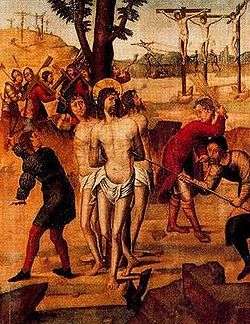Agathius
| Saint Agathius (Agathonas) | |
|---|---|
|
The Martyrdom of Saint Agathius. 16th century work by an anonymous artist from Toledo. | |
| Martyr | |
| Born | Cappadocia |
| Died |
~303 Byzantium |
| Venerated in |
Roman Catholicism Eastern Orthodox Church[1] |
| Major shrine | Cathedral of Squillace, Italy[2] |
| Feast | 8 May; 16 January (translation of relics) |
| Attributes | palm of martyrdom; centurion with a bunch of thorns; in armor with standard and shield; depicted with Theodore of Amasea |
| Patronage | soldiers; Squillace; Guardavalle; invoked against headache |
Saint Agathius (Greek: Ακακιος; died 303), also known as Achatius or Agathonas or Acacius of Byzantium, according to Christian tradition, was a Cappadocian Greek centurion of the imperial army, martyred around 304.
History
He was arrested for his faith on charges for being a Christian by Tribune Firmus in Perinthus, Thrace, tortured, and then brought to Byzantium (the later Constantinople), where he was scourged and beheaded, being made a martyr because he would not give up his Christian Faith.
The date of his martyrdom is traditionally May 8, when his feast is observed.
Veneration
Constantine the Great built a church in his honour. His relics were translated ca. 630 to a spring at Squillace, close by the Vivarium, the monastery founded in the previous century by Cassiodorus in the heel of Italy.[3] He was known in Squillace as San Agario. A relic of his arm was brought to Guardavalle in 1584 by the bishop of Squillace, Marcello Sirleto, hence Agathius' patronage of this city. Relics from Squillace were also brought to Cuenca and Ávila in Spain, where he is known as San Acato.[4]
St. Agathius is also venerated in Slovenia, where numerous churches and chapels are dedicated to him; this popular veneration goes back to the 16th century, when he was considered the patron saint of the fighters against the Ottoman Turks.[5] For the same reason he became popular among the Maniots, inhabitants of the Mani Peninsula in Greece, who took up his confrontation of the Pagan Roman authorities as a symbol of their own long lasting resistance of the Ottoman Empire's rule.
St. Achatius is one of the Fourteen Holy Helpers or Auxiliary Saints.
References
- ↑ (Greek) Ὁ Ἅγιος Ἀκάκιος ὁ Μάρτυρας ὁ κεντυρίων. 7 Μαΐου. ΜΕΓΑΣ ΣΥΝΑΞΑΡΙΣΤΗΣ.
- ↑ Benigni, Umberto. "Squillace." The Catholic Encyclopedia. Vol. 14. New York: Robert Appleton Company, 1912. 30 Dec. 2014
- ↑ Barnish, Samuel J., "Select Abstracts"
- ↑ "Sant' Agazio (Acacio)", Institute Cassiodoro
- ↑ "Ahacij in tovariši"
External links
| Wikimedia Commons has media related to Saint Acacius. |
